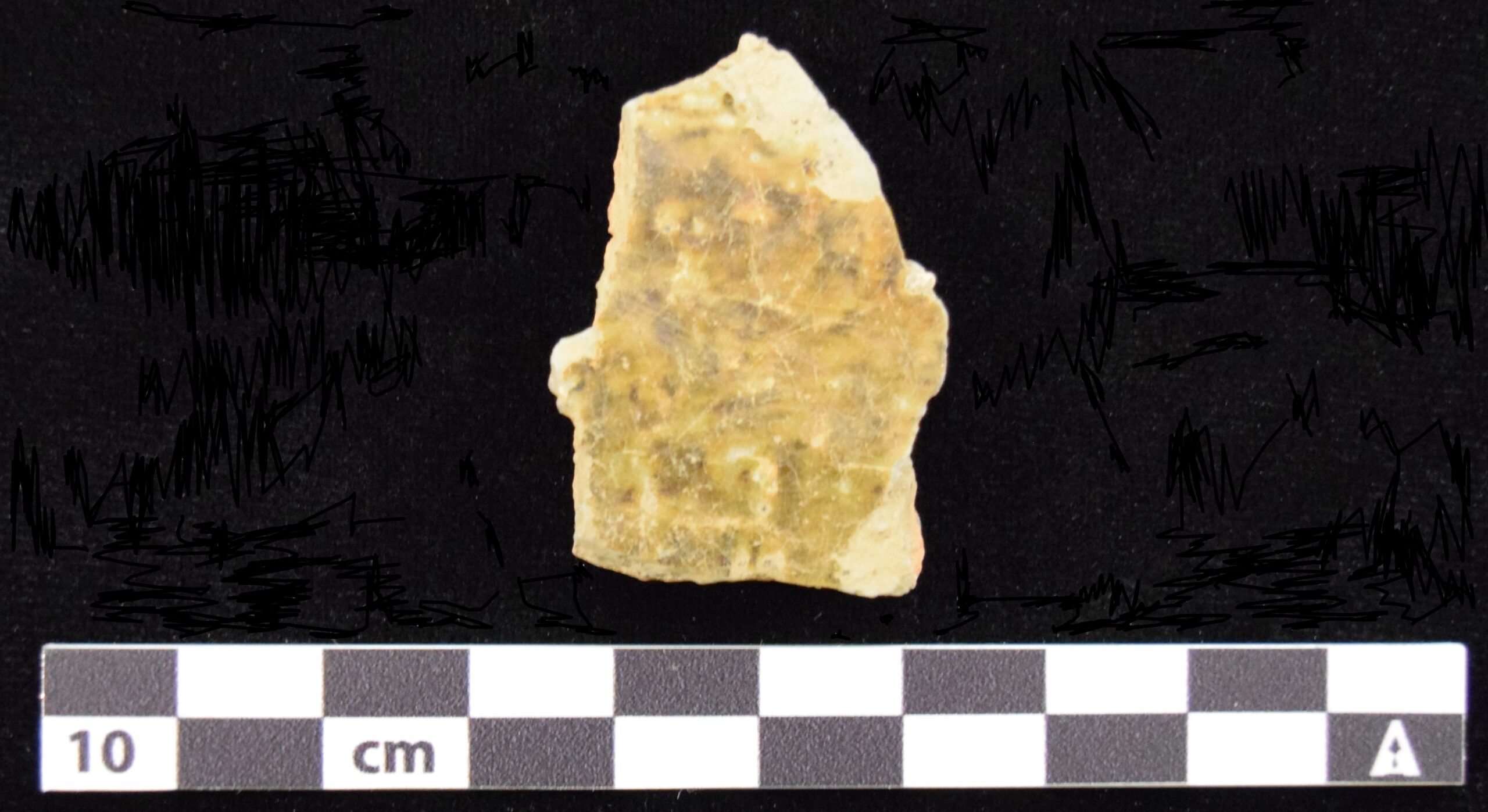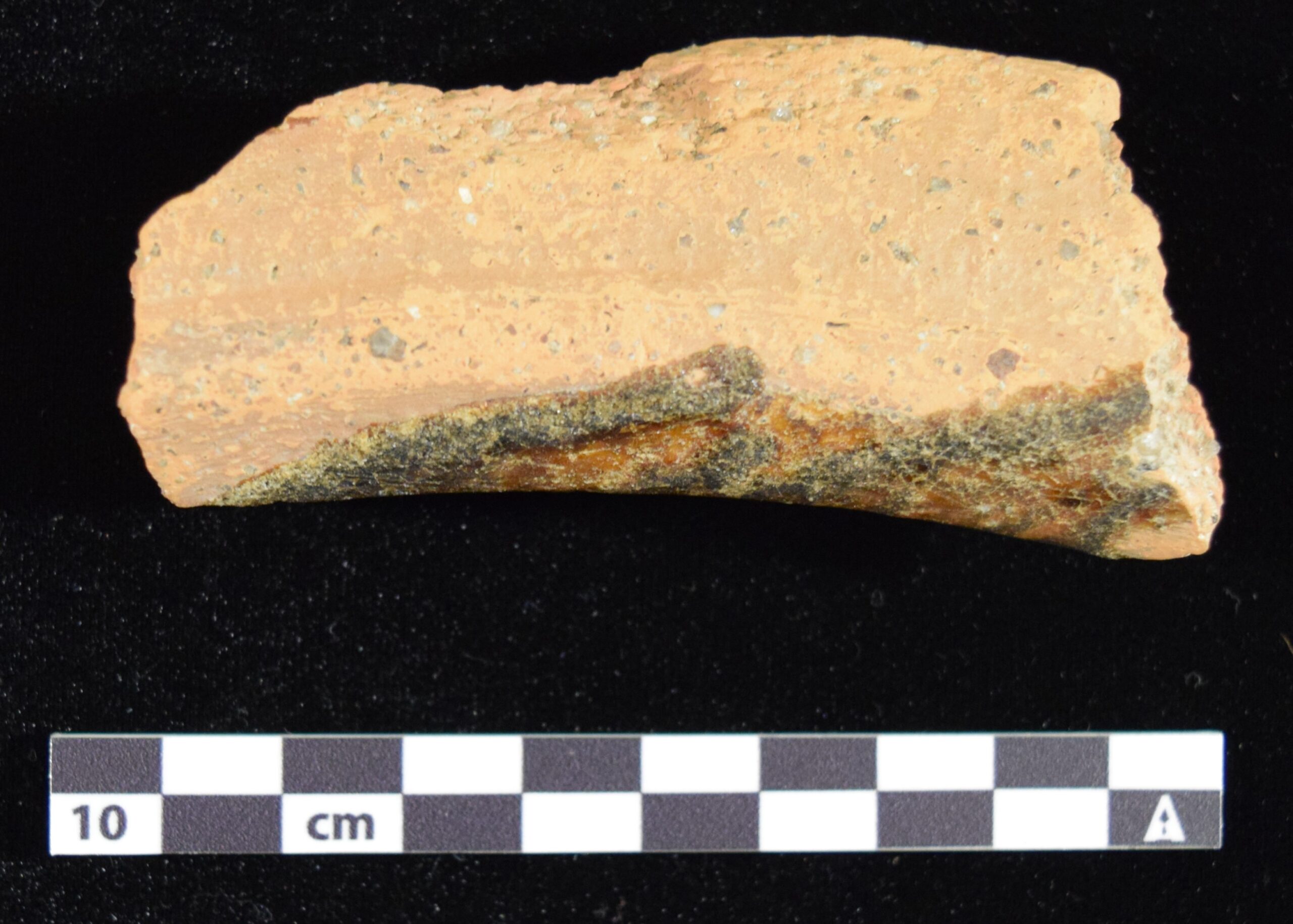Photo 1: North Devon Gravel-Tempered Milkpan Rim Sherd from the Chesapeake Region.
By Lee Priddy and Bill Liebeknecht
One of the more common types of ceramic found on early historic American archaeological sites is a ware called North Devon gravel-tempered earthenware (Photo 1). It is frequently encountered on archaeological sites in the Chesapeake region and in New England, but fragments are rare on colonial sites in Delaware. The question is, why? To answer this question, researchers have been examining professional and avocational archaeological collections in Delaware for these elusive wares with limited success. To date, North Devon gravel-tempered ware has only been reportedly found on eight archaeological sites throughout Delaware. The most recently recovered sherd of North Devon gravel-tempered ware was identified at the Carter Farm Area 1 Multicomponent Archaeological site (7NC-F-188) during a Phase IB archaeological survey performed by Dovetail Cultural Resource Group in partnership with South River Heritage Consulting.
North Devon wares originated from the North Devon area of western England, consisting of the towns of Barnstaple, Bideford, and Great Torrington. This utilitarian earthenware, typically used to make plates and trenchers, was exported in great numbers to the American colonies and can be further separated into three ceramic ware types: North Devon Sgrafitto, North Devon gravel-tempered, and North Devon gravel-free. North Devon Sgrafitto is characterized by incised slip decorations (where white kaolin clay is poured over red clay before firing and scratched through both layers to form a design) and dates from the 1620s through the end of the seventeenth century in the Chesapeake region. North Devon gravel-tempered ware was manufactured from 1600 through the nineteenth century. It was available in the Chesapeake region from circa 1650 through the first quarter of the eighteenth century. It is characterized by a yellow to brown, translucent lead glaze and the presence of pieces of large gravel in the body of the ceramic that was added to stiffen the clay to product larger vessels such as milk pans, washtubs, food storage vessels, butter jars, and even small ovens. Finally, North Devon gravel-free ware exhibited the same yellow to brown, translucent lead glaze but did not contain the addition of gravel. It has been found in the Chesapeake in pre-1635 contexts through the early eighteenth century (Grant 1983:53–62; Maryland Archaeological Conservation Lab 2015; Noël Hume 1991:104–105, 133–134; Pittman 1997; Watkins 1960:40, 45, 47).
Historical research of the colonial trade routes in Delaware leads to more questions. Delaware had close economic ties with Bristol, England—a city with close connections to the ceramic production centers at Barnstaple and Bedford. However, there is no record of the direct export of North Devon pottery from Barnstaple or Bideford to Delaware. Port record books show no evidence that earthenwares from the North Devon area of England were shipped out of Boston to New York or New Jersey, which had their own pottery centers. Could that explain why North Devon gravel-tempered ware is not more prevalent in archaeological collections from Delaware? The few sherds of North Devon gravel-tempered ware identified from sites in Delaware appear to date later into the eighteenth century, in direct contrast to the Chesapeake region (Fithian n.d.:1–2; Grant 1983:24–27; Watkins 1960:125) (Table 1).
Table 1. Delaware Site with Reported North Devon Gravel-Tempered Ware (Data gathered from the Delaware Division of Historical and Cultural Affairs and Gall et al. 2018).

In May 2023, Phase I archaeological survey at Carter Farm Area 1 Multicomponent Archaeological site (7NC-F-188) recovered a single sherd of North Devon gravel-tempered ware from the surface of the plow zone (Bianchi et al. 2023:50, 53). The sherd is a wheel-thrown flat ceramic vessel with classic gravel temper and greenish-brown lead glaze on its interior (Photo 2 and Photo 3). This domestic site has been tentatively dated from the late-seventeenth or early-eighteenth century to circa 1780. Other early ceramic types recovered from the site consist of Buckley ware, Westerwald stoneware, tin-glazed earthenware, and dipped white salt-glazed stoneware. These ware types coincide with the prescribed date range for North Devon gravel-tempered wares, suggesting the identification of this sherd is accurate.

Photo 2: Interior Surface of North Devon Gravel-Tempered Body Sherd from 7NC-F-188.

Photo 3: Exterior Surface of North Devon Gravel-Tempered Body Sherd from 7NC-F-188.
Although North Devon gravel-tempered earthenware is rarely observed on archaeological sites in Delaware, a closer examination of the collections stored at the Delaware State Museum may reveal it is more plentiful than we are currently aware. Redware and pale-bodied earthenware are often lumped together and overlooked in archaeological collections, so this ware type could be easily misidentified, even with its distinctive gravel tempering. With its prevalence in the Chesapeake region, Colonial-era sites along the southern and western borders of the state may hold a higher potential to find North Devon gravel-tempered ware as it would have been shipped up the Chesapeake Bay, which borders Delaware. Sites dominated by redware need to be examined carefully to ensure that North Devon gravel-tempered earthenware is not overlooked. Future fieldwork at Carter Farm Area 1 Multicomponent Archaeological site (7NC-F-188) coupled with additional historic research may help answer why North Devon gravel-tempered ware is as rare as hens’ teeth in Delaware. It is hoped that planned Phase II testing at the site on Carter Farm will provide additional information on this obscure ware type in Delaware.
Bibliography
Bianchi, Lucia, Andrew Martin, Lee Priddy, and Bill Liebeknecht
2023 Phase IB Archaeological Survey of Carter Farm in Middletown, Pencader Hundred, New Castle County, Delaware. Dovetail Cultural Resource Group, Fredericksburg, Virginia.
Gall, Michael, Ilene Grossman-Bailey, Philip Hayden, and Adam Heinrich
2018 Living on the Boder; Phase II Archaeological Survey and Phase III Archaeological Data Recovery – Locus 1 of the Rumsey/Polk Tenant/Prehistoric Site (7NC-F-112, CRS # N-14492). Richard Grubb and Associates, Cranberry, New Jersey.
Grant, Alison
1983 North Devon Pottery: The Seventeenth Century. The University of Exeter, Exeter, England.
Fithian, Charles
n.d. North Devon Earthenwares in Delaware. Electronic document, https://apps.jefpat.maryland.gov/diagnostic/ColonialCeramics/Colonial%20Ware%20Descriptions/North%20Devon%20Gravel%20tempered%20final%20.pdf, accessed April 2024.
Maryland Archaeological Conservation Lab
2015 Ceramics in Maryland. Diagnostic Artifacts in Maryland. Electronic document, https://apps.jefpat.maryland.gov/diagnostic/index-Ceramics.html, accessed March 2024.
Noël Hume, Ivor
1991 A Guide to Artifacts of Colonial America. Reprint of 1969 edition. Random House, New York, New York.
Pittman, William
1997 Lee Priddy original unpublished lecture notes from Fall 1997 Introduction to Historical Archaeology class (HIST 607), lecturer William Pittman, Colonial Williamsburg Department of Archaeological Research, College of William & Mary, in Williamsburg, Virginia. Manuscript on file at Dovetail Cultural Resource Group, Fredericksburg, Virginia.
Watkins, C. Malcolm
1960 North Devon Pottery and its Export to American in the 17th Century. Bulletin 225, United States National Museum, Washington D.C.

